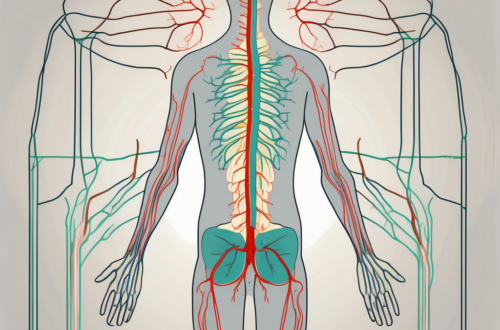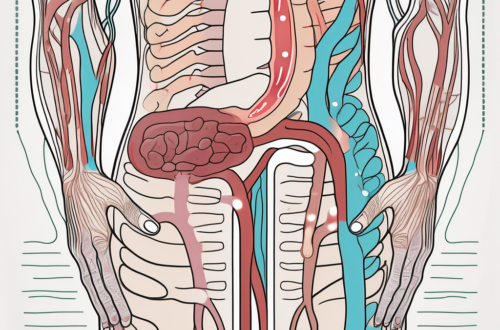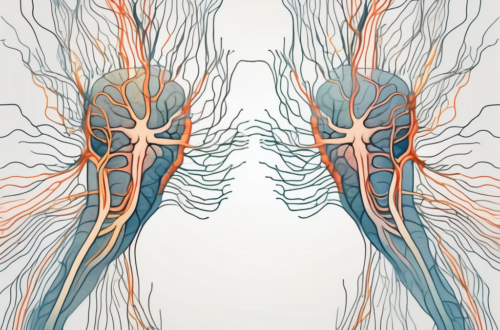The parasympathetic nervous system plays a crucial role in various bodily functions, including digestion. Understanding how this system functions can shed light on its influence on processes such as peristalsis. Furthermore, exploring the science behind peristalsis and its connection to the parasympathetic nervous system can provide insights into the potential impact of parasympathetic nerve stimulation on this essential bodily function. In this article, we will delve into these topics to explore the impact of parasympathetic nerve stimulation on peristalsis.
Understanding the Parasympathetic Nervous System
The parasympathetic nervous system is one of the three divisions of the autonomic nervous system, along with the sympathetic and enteric nervous systems. It operates in opposition to the sympathetic nervous system, which is responsible for the “fight or flight” response. In contrast, the parasympathetic nervous system regulates the body’s rest and digest state, promoting relaxation and digestion.
The Role of the Parasympathetic Nervous System in the Body
The parasympathetic nervous system is associated with various bodily functions. It helps regulate heart rate, pupil constriction, salivary gland secretion, and many other activities that occur during relaxation. Moreover, it also plays a crucial role in supporting digestive processes such as peristalsis.
Peristalsis is the rhythmic contraction and relaxation of the muscles in the digestive tract that helps move food along the digestive system. When the parasympathetic nervous system is activated, it stimulates the muscles in the esophagus, stomach, and intestines to contract and relax in a coordinated manner, facilitating the smooth movement of food.
In addition to peristalsis, the parasympathetic nervous system also influences the secretion of digestive enzymes and juices. These substances are essential for breaking down complex nutrients into simpler molecules that can be absorbed by the body. The activation of the parasympathetic nervous system triggers the release of enzymes and juices from various glands, including the salivary glands, pancreas, and liver.
Furthermore, the parasympathetic nervous system plays a vital role in directing blood flow to the digestive organs. When the body is in a relaxed state, the parasympathetic nervous system dilates the blood vessels supplying the digestive system, ensuring an adequate supply of oxygen and nutrients to support the digestive processes.
The Connection Between the Parasympathetic Nervous System and Digestion
When it comes to digestion, the parasympathetic nervous system regulates specific activities that facilitate the breakdown and absorption of nutrients. It directs blood flow to the digestive organs, stimulates the secretion of digestive enzymes and juices, and influences the movement of food along the digestive tract, including peristalsis.
Moreover, the parasympathetic nervous system also influences the release of bile from the gallbladder. Bile is a substance produced by the liver that aids in the digestion and absorption of fats. When the parasympathetic nervous system is activated, it signals the gallbladder to contract, releasing bile into the small intestine to aid in the breakdown of fats.
Additionally, the parasympathetic nervous system promotes the relaxation of the smooth muscles in the digestive tract. This relaxation allows the digestive organs to expand and accommodate the food being processed, ensuring efficient digestion and absorption of nutrients.
Overall, the parasympathetic nervous system plays a crucial role in maintaining the body’s rest and digest state. By regulating various activities such as peristalsis, enzyme secretion, blood flow, and muscle relaxation, it ensures that the digestive system functions optimally, allowing for the efficient breakdown and absorption of nutrients.
The Science of Peristalsis
Peristalsis is a vital process involved in moving food through the digestive system. It is a wave-like muscular contraction that pushes food from the esophagus down to the stomach and through the intestines. Understanding the process and purpose of peristalsis is fundamental in comprehending how parasympathetic nerve stimulation may impact it.
The Process and Purpose of Peristalsis
Peristalsis relies on coordinated muscle contractions and relaxations along the digestive tract walls. As food enters the digestive system, it triggers a series of muscle contractions behind it. These contractions push the food forward, propelling it through the digestive tract. This process is crucial for the efficient digestion and absorption of nutrients.
Imagine a delicious meal being consumed. As the food enters the esophagus, the muscles in the walls of the esophagus contract, creating a wave-like motion that propels the food downward. This wave of contractions continues as the food reaches the stomach, where it is mixed with digestive juices and broken down into smaller particles. The contractions then push the partially digested food into the small intestine, where further digestion and absorption of nutrients occur.
Throughout this journey, peristalsis ensures that the food moves steadily and consistently through the digestive system. Without peristalsis, the food would remain stagnant, leading to discomfort and potential complications in the digestive process.
Factors Influencing Peristalsis
Various factors can influence peristalsis. One significant factor is the type and consistency of food. For example, high-fiber foods tend to stimulate stronger and more frequent contractions, aiding in the movement of food through the digestive system. On the other hand, low-fiber or processed foods may result in weaker contractions, potentially leading to slower digestion.
Additionally, stress can have a significant impact on peristalsis. When we are stressed, our body’s sympathetic nervous system is activated, which can disrupt the normal rhythm of peristalsis. This can lead to irregular or slowed movement of food through the digestive system, causing discomfort and digestive issues.
Hormonal imbalances can also affect peristaltic movements. Hormones such as serotonin and motilin play a role in regulating the contractions of the digestive tract. Any imbalance in these hormones can disrupt the normal peristaltic process, leading to digestive disturbances.
Furthermore, certain medications, such as opioids, can slow down peristalsis. Opioids bind to receptors in the digestive tract, inhibiting the muscle contractions necessary for efficient movement of food. This can result in constipation and other gastrointestinal issues.
Lastly, certain medical conditions, such as irritable bowel syndrome (IBS) or gastroparesis, can affect peristalsis. In IBS, the contractions of the digestive tract may be too strong or too weak, leading to abdominal pain, bloating, and altered bowel habits. Gastroparesis, on the other hand, is a condition where the stomach muscles do not contract properly, causing delayed emptying of the stomach.
Understanding these factors that influence peristalsis is crucial in identifying potential avenues for intervention. For example, parasympathetic nerve stimulation can be used to enhance peristaltic movements in individuals with impaired digestion. By activating the parasympathetic nervous system, which is responsible for promoting rest and digestion, peristalsis can be improved, leading to better digestive function.
Parasympathetic Nerve Stimulation Explained
Parasympathetic nerve stimulation refers to techniques or treatments that aim to activate the parasympathetic nervous system. By stimulating the parasympathetic nerves, it may be possible to enhance the rest and digest state of the body, promoting optimal digestion, including peristalsis.
The parasympathetic nervous system is one of the two branches of the autonomic nervous system, responsible for regulating involuntary bodily functions. It is often referred to as the “rest and digest” system because it helps the body relax, conserve energy, and promote digestion.
When the parasympathetic nerves are stimulated, a cascade of physiological responses occurs. These responses work together to create a state of relaxation and promote optimal digestive function.
Techniques for Stimulating the Parasympathetic Nerves
There are various techniques available to stimulate the parasympathetic nerves. These include breathing exercises, meditation, and specific therapeutic interventions. However, it is crucial to note that before considering any technique, it is advisable to consult with a medical professional to ensure suitability and safety.
One popular technique for stimulating the parasympathetic nerves is deep diaphragmatic breathing. This involves taking slow, deep breaths, filling the lungs completely, and exhaling fully. This type of breathing activates the vagus nerve, which is a major component of the parasympathetic nervous system.
Meditation is another effective method for stimulating the parasympathetic nerves. By practicing mindfulness and focusing on the present moment, individuals can activate the relaxation response and promote overall well-being.
Specific therapeutic interventions, such as acupuncture and acupressure, can also stimulate the parasympathetic nerves. These techniques involve applying pressure to specific points on the body, which can help restore balance and activate the rest and digest state.
The Physiological Effects of Parasympathetic Nerve Stimulation
Parasympathetic nerve stimulation can have several physiological effects on the body. It can promote relaxation, reduce heart rate and blood pressure, increase blood flow to the digestive organs, and enhance the secretion of digestive enzymes and juices. These effects may positively influence peristalsis and overall digestive function.
When the parasympathetic nervous system is activated, the body enters a state of deep relaxation. This relaxation response helps reduce stress and anxiety, allowing the body to focus on digestion and nutrient absorption.
Reduced heart rate and blood pressure are also common effects of parasympathetic nerve stimulation. This is because the parasympathetic system counteracts the effects of the sympathetic nervous system, which is responsible for the “fight or flight” response. By activating the parasympathetic nerves, heart rate and blood pressure decrease, promoting a calm and relaxed state.
Increased blood flow to the digestive organs is another important effect of parasympathetic nerve stimulation. This enhanced blood flow ensures that the digestive system receives the necessary oxygen and nutrients to function optimally. It also helps promote the secretion of digestive enzymes and juices, which aid in the breakdown and absorption of nutrients.
Overall, parasympathetic nerve stimulation plays a crucial role in maintaining a healthy digestive system. By promoting relaxation, reducing heart rate and blood pressure, and enhancing blood flow and digestive secretions, it supports optimal digestion and peristalsis.
The Direct Impact of Parasympathetic Nerve Stimulation on Peristalsis
Understanding how parasympathetic nerve stimulation directly affects peristalsis is of paramount importance in comprehending its potential impact on digestion and overall health. By investigating the specific mechanisms involved, we can gain insights into the potential benefits and long-term effects of parasympathetic nerve stimulation on peristalsis.
Peristalsis, the wave-like contractions that propel food through the digestive tract, is a complex process involving the coordination of various muscles and nerves. The parasympathetic nervous system plays a crucial role in regulating peristalsis by promoting relaxation of the digestive tract muscles and enhancing the forward movement of food.
When parasympathetic nerves are stimulated, they release neurotransmitters such as acetylcholine, which bind to receptors on smooth muscle cells in the digestive tract. This binding triggers a cascade of events that ultimately lead to muscle relaxation and increased peristaltic contractions.
One of the key mechanisms by which parasympathetic nerve stimulation enhances peristalsis is through the activation of the enteric nervous system, also known as the “second brain” of the gut. The enteric nervous system consists of a complex network of neurons that are responsible for regulating various aspects of digestion, including peristalsis.
Upon stimulation, the parasympathetic nerves release acetylcholine, which acts on receptors located on enteric neurons. This activation leads to the release of neurotransmitters such as serotonin and dopamine, which further modulate peristalsis by influencing the excitability of the enteric neurons.
Furthermore, parasympathetic nerve stimulation can also increase blood flow to the digestive tract, providing the necessary oxygen and nutrients for optimal muscle function. This improved blood flow can enhance the efficiency of peristalsis and contribute to overall digestive health.
How Parasympathetic Nerve Stimulation Affects Peristalsis
Parasympathetic nerve stimulation can influence peristalsis by promoting relaxation of the digestive tract muscles and enhancing the wave-like contractions responsible for pushing food forward. By activating the parasympathetic nerves, it may be possible to improve peristalsis and optimize the digestive process. However, further research is necessary to better understand the precise mechanisms involved.
Studies have shown that parasympathetic nerve stimulation, through techniques such as deep breathing exercises, meditation, or certain medications, can have a direct impact on peristalsis. These techniques aim to activate the parasympathetic nervous system, leading to increased acetylcholine release and subsequent modulation of peristaltic activity.
Additionally, the gut-brain connection plays a significant role in the effects of parasympathetic nerve stimulation on peristalsis. The brain and the gut are intricately connected through a bidirectional communication pathway known as the gut-brain axis. Stress, anxiety, and other emotional factors can influence peristalsis through the activation of the sympathetic nervous system, which opposes the actions of the parasympathetic nervous system. By engaging in activities that stimulate the parasympathetic nervous system, individuals may be able to counteract the negative effects of stress and promote healthy peristalsis.
It is important to note that the effects of parasympathetic nerve stimulation on peristalsis may vary among individuals. Factors such as age, underlying medical conditions, and medication use can influence the responsiveness of the digestive system to parasympathetic stimulation. Therefore, a personalized approach, guided by a healthcare professional, is crucial to ensure the safety and effectiveness of any intervention.
The Long-Term Effects of Parasympathetic Nerve Stimulation on Peristalsis
While parasympathetic nerve stimulation shows promise in potentially improving peristalsis, the long-term effects warrant further investigation. It is important to consider individual variations and potential risks associated with any intervention. As such, it is advisable to consult with a qualified healthcare professional who can provide personalized advice based on the individual’s medical history and current condition.
Long-term studies assessing the effects of sustained parasympathetic nerve stimulation on peristalsis are currently limited. It is crucial to understand the potential risks and benefits of prolonged stimulation to ensure its safety and efficacy. Additionally, the impact of parasympathetic nerve stimulation on other aspects of digestion, such as nutrient absorption and gut microbiota, should also be explored.
Furthermore, the potential applications of parasympathetic nerve stimulation extend beyond peristalsis and digestion. Research suggests that parasympathetic nerve stimulation may have broader health benefits, including stress reduction, improved sleep, and enhanced overall well-being. These potential effects highlight the interconnectedness of the nervous system and its influence on various physiological processes.
In conclusion, understanding the direct impact of parasympathetic nerve stimulation on peristalsis is a complex and evolving field of research. While current evidence suggests that parasympathetic nerve stimulation can enhance peristalsis, further studies are needed to fully elucidate the underlying mechanisms and long-term effects. By gaining a deeper understanding of these processes, we can potentially develop targeted interventions to optimize digestive health and overall well-being.
Implications for Health and Medicine
The potential impact of parasympathetic nerve stimulation on peristalsis has implications for both health and medicine. Understanding the relationship between the parasympathetic nervous system and peristalsis opens up new avenues for therapeutic applications and potential interventions.
Potential Therapeutic Applications of Parasympathetic Nerve Stimulation
Parasympathetic nerve stimulation may hold promise as a therapeutic intervention for individuals experiencing peristaltic abnormalities or digestive issues. By promoting optimal rest and digest state, it could potentially facilitate the movement of food through the digestive system, improving overall digestive function and health. However, it is essential to approach any therapeutic intervention with caution and under the guidance of a healthcare professional.
Risks and Considerations in Parasympathetic Nerve Stimulation Therapy
As with any medical therapy, parasympathetic nerve stimulation therapy is not without risks and considerations. Individual variations, medical conditions, and medications may impact the feasibility and safety of such interventions. It is imperative to consult with a qualified healthcare professional who can assess the individual’s situation and provide appropriate advice and guidance regarding potential risks and benefits.
In conclusion, the impact of parasympathetic nerve stimulation on peristalsis is an area of growing interest. The parasympathetic nervous system plays a vital role in regulating digestion, including processes such as peristalsis. While parasympathetic nerve stimulation shows promise in potentially optimizing digestive function, further research is necessary to fully understand its mechanisms and long-term effects. Consulting with a medical professional is essential for individualized advice and guidance. By gaining a deeper understanding of the relationship between the parasympathetic nervous system and peristalsis, we can potentially uncover new possibilities for therapeutic interventions and improved digestive health.





